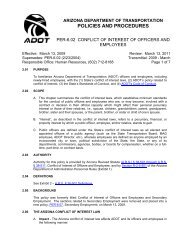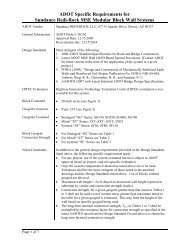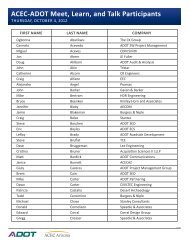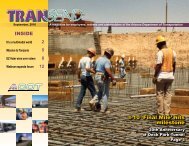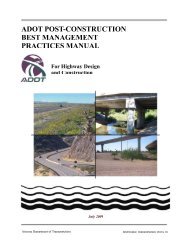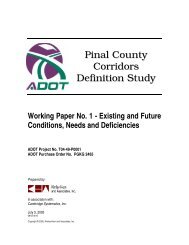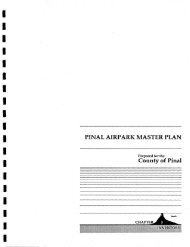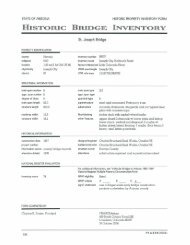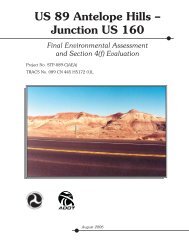I-10 Twin Peaks Traffic Interchange, Environmental Assessment
I-10 Twin Peaks Traffic Interchange, Environmental Assessment
I-10 Twin Peaks Traffic Interchange, Environmental Assessment
Create successful ePaper yourself
Turn your PDF publications into a flip-book with our unique Google optimized e-Paper software.
Affected Environment and <strong>Environmental</strong> Impacts October 2005<br />
closed basin of internal drainage. The Fort Lowell Formation, which is generally<br />
300 to 400 feet thick, grades from silty gravel near the edges of the basin to silty<br />
sand and clayey silt in the central part of the basin. In most of the basin, the Fort<br />
Lowell Formation was deposited in fans by streams that spread out from the<br />
canyons in the surrounding mountains. The Tinaja beds, which vary from less than<br />
one foot to more than 2,000 feet thick and have up to three subunits, consist of<br />
gravel and sand (upper bed) that grade into a very thick sequence of gypsiferous<br />
clayey silt and mudstone in the center of the basin (lower bed). The Fort Lowell<br />
formation is early and middle Pleistocene in age, while the Tinaja beds range in<br />
age from Miocene to Pliocene. Tilting, accompanied by minor faulting, ended the<br />
sedimentation of the Fort Lowell Formation and initiated erosion and the early<br />
stages of the present drainage system, including the deposition of young<br />
Quaternary alluvium along the Santa Cruz River.<br />
Localized Surficial Geology<br />
Since the project site is located within or close to the range of influence of the<br />
meander migration of the Santa Cruz River, it can be expected that the near surface<br />
soil deposits would exhibit gradational characteristics ranging from fluvialdeposited<br />
silty and clayey soils to sandy and gravelly deposits. Below these<br />
surficial deposits, dense layers of sand and gravel of the Fort Lowell Formation<br />
with varying quantities of silt and clay would be encountered. The base of the Fort<br />
Lowell Formation is expected to be at approximately 2,000 feet, or approximately<br />
130 feet below existing grade, and so the very dense Upper Tinaja unit is unlikely<br />
to be encountered on this project.<br />
Seismic Conditions<br />
Based on ADOT seismic acceleration maps (Euge, Kenneth, and Schell 1992) and<br />
AASHTO Standard Specifications for Highway Bridges, seismic loading is not<br />
incorporated in the design of the bridges. Furthermore, there are no special seismic<br />
design requirements for the foundations and abutments of bridges in this category.<br />
Mineral Resources<br />
Sand and gravel mining operations have operated and continue to operate within<br />
the study area. An existing sand and gravel mining operation (I-<strong>10</strong> Avra Valley<br />
Mining and Development) is located on the west side of the Santa Cruz River<br />
south of Avra Valley Road, which is north of the project area. Although no longer<br />
a mining operation, a former sand and gravel mine was located in the northern<br />
portion of the project area between the Santa Cruz River and I-<strong>10</strong>. This area is now<br />
used for industrial operations. An active sand and gravel mining operation (Rinker<br />
Materials) is located in the southern project area immediately south of the south<br />
access road. In addition to sand and gravel mining, Arizona Block and Brick, in<br />
the southern portion of the project area mines and processes raw material on-site<br />
into adobe block.<br />
Interstate <strong>10</strong> <strong>Traffic</strong> <strong>Interchange</strong> at<br />
<strong>Twin</strong> <strong>Peaks</strong>/Linda Vista<br />
4-7<br />
Project No.: NH-0<strong>10</strong>-D (AIW)<br />
TRACS No.: <strong>10</strong> PM 236 H5838 01D



